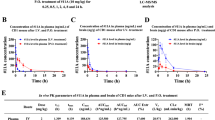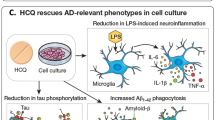Abstract
Epidemiological studies have documented a reduced prevalence of Alzheimer's disease among users of nonsteroidal anti-inflammatory drugs (NSAIDs)1,2,3,4,5. It has been proposed that NSAIDs exert their beneficial effects in part by reducing neurotoxic inflammatory responses in the brain, although this mechanism has not been proved. Here we report that the NSAIDs ibuprofen, indomethacin and sulindac sulphide preferentially decrease the highly amyloidogenic Aβ42 peptide (the 42-residue isoform of the amyloid-β peptide) produced from a variety of cultured cells by as much as 80%. This effect was not seen in all NSAIDs and seems not to be mediated by inhibition of cyclooxygenase (COX) activity, the principal pharmacological target of NSAIDs6. Furthermore, short-term administration of ibuprofen to mice that produce mutant β-amyloid precursor protein (APP) lowered their brain levels of Aβ42. In cultured cells, the decrease in Aβ42 secretion was accompanied by an increase in the Aβ(1–38) isoform, indicating that NSAIDs subtly alter γ-secretase activity without significantly perturbing other APP processing pathways or Notch cleavage. Our findings suggest that NSAIDs directly affect amyloid pathology in the brain by reducing Aβ42 peptide levels independently of COX activity and that this Aβ42-lowering activity could be optimized to selectively target the pathogenic Aβ42 species.
This is a preview of subscription content, access via your institution
Access options
Subscribe to this journal
Receive 51 print issues and online access
$199.00 per year
only $3.90 per issue
Buy this article
- Purchase on Springer Link
- Instant access to full article PDF
Prices may be subject to local taxes which are calculated during checkout




Similar content being viewed by others

References
Akiyama, H. et al. Inflammation and Alzheimer's disease. Neurobiol. Aging 21, 383–421 (2000).
McGeer, P. L., Schulzer, M. & McGeer, E. G. Arthritis and anti-inflammatory agents as possible protective factors for Alzheimer's disease: a review of 17 epidemiologic studies. Neurology 47, 425–432 (1996).
Rogers, J. et al. Clinical trial of indomethacin in Alzheimer's disease. Neurology 43, 1609–1611 (1993).
Anthony, J. C. et al. Reduced prevalence of AD in users of NSAIDs and H2 receptor antagonists: the Cache County study. Neurology 54, 2066–2071 (2000).
Stewart, W. F., Kawas, C., Corrada, M. & Metter, E. J. Risk of Alzheimer's disease and duration of NSAID use. Neurology 48, 626–632 (1997).
Smith, W. L., DeWitt, D. L. & Garavito, R. M. Cyclooxygenases: structural, cellular, and molecular biology. Annu. Rev. Biochem. 69, 145–182 (2000).
Younkin, S. G. The role of Aβ42 in Alzheimer's disease. J. Physiol. Paris 92, 289–292 (1998).
Murphy, M. P. et al. Presenilin 1 regulates pharmacologically distinct γ-secretase activities. Implications for the role of presenilin in γ-secretase cleavage. J. Biol. Chem. 275, 26277–26284 (2000).
McEvoy, G. K. AHFS Drug Information (American Society of Health-System Pharmacists, Bethesda, 1998).
Janne, P. A. & Mayer, R. J. Chemoprevention of colorectal cancer. N. Engl. J. Med. 342, 1960–1968 (2000).
Lim, G. P. et al. Ibuprofen suppresses plaque pathology and inflammation in a mouse model for Alzheimer's disease. J. Neurosci. 20, 5709–5714 (2000).
Piazza, G. A. et al. Apoptosis primarily accounts for the growth-inhibitory properties of sulindac metabolites and involves a mechanism that is independent of cyclooxygenase inhibition, cell cycle arrest, and p53 induction. Cancer Res. 57, 2452–2459 (1997).
Cryer, B. & Feldman, M. Cyclooxygenase-1 and cyclooxygenase-2 selectivity of widely used nonsteroidal anti-inflammatory drugs. Am. J. Med. 104, 413–421 (1998).
Zhang, X., Morham, S. G., Langenbach, R. & Young, D. A. Malignant transformation and antineoplastic actions of nonsteroidal antiinflammatory drugs (NSAIDs) on cyclooxygenase-null embryo fibroblasts. J. Exp. Med. 190, 451–459 (1999).
Abdel-Halim, M. S., Sjoquist, B. & Anggard, E. Inhibition of prostaglandin synthesis in rat brain. Acta Pharmacol. Toxicol. 43, 266–272 (1978).
Li, Y. M. et al. Photoactivated γ-secretase inhibitors directed to the active site covalently label presenilin 1. Nature 405, 689–694 (2000).
De Strooper, B. et al. A presenilin-1-dependent γ-secretase-like protease mediates release of Notch intracellular domain. Nature 398, 518–522 (1999).
Hadland, B. K. et al. γ-secretase inhibitors repress thymocyte development. Proc. Natl Acad. Sci. USA 98, 7487–7491 (2001).
Yankner, B. A. et al. Neurotoxicity of a fragment of the amyloid precursor associated with Alzheimer's disease. Science 245, 417–420 (1989).
Oster-Granite, M. L., McPhie, D. L., Greenan, J. & Neve, R. L. Age-dependent neuronal and synaptic degeneration in mice transgenic for the C terminus of the amyloid precursor protein. J. Neurosci. 16, 6732–6741 (1996).
Perez, R. G. et al. Mutagenesis identifies new signals for β-amyloid precursor protein endocytosis, turnover, and the generation of secreted fragments, including Aβ42. J. Biol. Chem. 274, 18851–18856 (1999).
Kopan, R., Schroeter, E. H., Weintraub, H. & Nye, J. S. Signal transduction by activated mNotch: importance of proteolytic processing and its regulation by the extracellular domain. Proc. Natl Acad. Sci. USA 93, 1683–1688 (1996).
Wiltfang, J. et al. Improved electrophoretic separation and immunoblotting of β-amyloid (Aβ) peptides 1–40, 1–42, and 1–43. Electrophoresis 18, 527–532 (1997).
Qiu, W. Q. et al. Insulin-degrading enzyme regulates extracellular levels of amyloid β-protein by degradation. J. Biol. Chem. 273, 32730–32738 (1998).
Iwata, N. et al. Identification of the major Aβ1-42-degrading catabolic pathway in brain parenchyma: suppression leads to biochemical and pathological deposition. Nature Med. 6, 143–150 (2000).
Kang, D. E. et al. Modulation of amyloid β-protein clearance and Alzheimer's disease susceptibility by the LDL receptor-related protein pathway. J. Clin. Invest. 106, 1159–1166 (2000).
McGeer, P. L. Cyclo-oxygenase-2 inhibitors: rationale and therapeutic potential for Alzheimer's disease. Drugs Aging 17, 1–11 (2000).
Yuan, H. et al. Recombinant adenovirus is an appropriate vector for endocytotic protein trafficking studies in cultured neurons. J. Neurosci. Methods 88, 45–54 (1999).
Wang, R., Sweeney, D., Gandy, S. E. & Sisodia, S. S. The profile of soluble amyloid β protein in cultured cell media. Detection and quantification of amyloid β protein and variants by immunoprecipitation-mass spectrometry. J. Biol. Chem. 271, 31894–31902 (1996).
Kawarabayashi, T. et al. Age-dependent changes in brain, CSF, and plasma amyloid (β) protein in the Tg2576 transgenic mouse model of Alzheimer's disease. J. Neurosci. 21, 372–381 (2001).
Acknowledgements
We thank X. Zhang and D. A. Young for fibroblasts deficient in COX-1 and COX-2; R. Kopan for Notch plasmids; M. Kounnas for 26D6 antibody; P. Sims, D. Galasko and C. Eckman for discussions; and Takeda industries for the BAN50, BA27 and BC05 antibodies. We also thank P. Needleman for his scientific input. This work was supported by National Institutes of Health grants (E.H.K., T.E.G., R.W.), a Beeson Award (T.E.G.), an Ellison Medical Foundation New Scholars award (T.E.G.), a Robert and Clarice Smith Fellowship (P.D.), a John Douglas French Alzheimer's Foundation Fellowship (M.P.M.), and an Emmy Noether fellowship from the Deutsche Forschungsgemeinschaft (S.W.).
Author information
Authors and Affiliations
Corresponding author
Supplementary information
Rights and permissions
About this article
Cite this article
Weggen, S., Eriksen, J., Das, P. et al. A subset of NSAIDs lower amyloidogenic Aβ42 independently of cyclooxygenase activity. Nature 414, 212–216 (2001). https://doi.org/10.1038/35102591
Received:
Accepted:
Issue Date:
DOI: https://doi.org/10.1038/35102591
This article is cited by
-
Amyloid fibril proteomics of AD brains reveals modifiers of aggregation and toxicity
Molecular Neurodegeneration (2023)
-
Turning the tide on Alzheimer’s disease: modulation of γ-secretase
Cell & Bioscience (2022)
-
γ-Secretase in Alzheimer’s disease
Experimental & Molecular Medicine (2022)
-
Disease-Modifying Therapies for Alzheimer's Disease: More Questions than Answers
Neurotherapeutics (2022)
-
Identification and drug-induced reversion of molecular signatures of Alzheimer’s disease onset and progression in AppNL-G-F, AppNL-F, and 3xTg-AD mouse models
Genome Medicine (2021)
Comments
By submitting a comment you agree to abide by our Terms and Community Guidelines. If you find something abusive or that does not comply with our terms or guidelines please flag it as inappropriate.


